
Third generation of the mid-engined sports car
Built for driving enthusiasts, the 2014 Porsche Cayman sets a new standard for performance with a longer wheelbase, new chassis and reduced weight. On the heels of the new 911 Carrera and Boxster, this completely redeveloped two-seater is now the third Porsche sports car to use new lightweight body construction technology recently developed by Porsche. The new Cayman is up to 60 pounds lighter, depending on specific model and equipment, and when equipped with the Porsche Doppelkupplungsgetriebe (PDK), the Cayman has a U.S. EPA highway label fuel economy value of 32 mpg, despite an increase in power and torque.
Cayman
2.7-liter flat-six cylinder engine with 275 hp; rear-wheel drive, six-speed manual transmission, optional seven-speed Porsche Doppelkupplungsgetriebe (PDK); acceleration from zero to 60 mph in 5.4 seconds, with PDK in 5.3 seconds (5.1 seconds with Sport Chrono package); top speed 165 mph, with PDK 164 mph; U.S. EPA highway label fuel economy 30 mpg; with PDK 32 mpg.
Cayman S
3.4-liter flat-six cylinder engine with 325 hp; rear-wheel drive, six-speed manual transmission, optional seven-speed Porsche Doppelkupplungsgetriebe (PDK); acceleration from zero to 60 mph in 4.7 seconds, with PDK in 4.6 seconds (4.4 seconds with Sport Chrono package); top speed 175 mph, 174 mph with PDK; U.S. EPA highway label fuel economy 28 mpg; with PDK 30 mpg.
Optional for the first time in the Cayman are Adaptive Cruise Control (ACC), which controls vehicle distance and speed in traffic, a specially developed Burmester® sound system, and Porsche Entry & Drive.
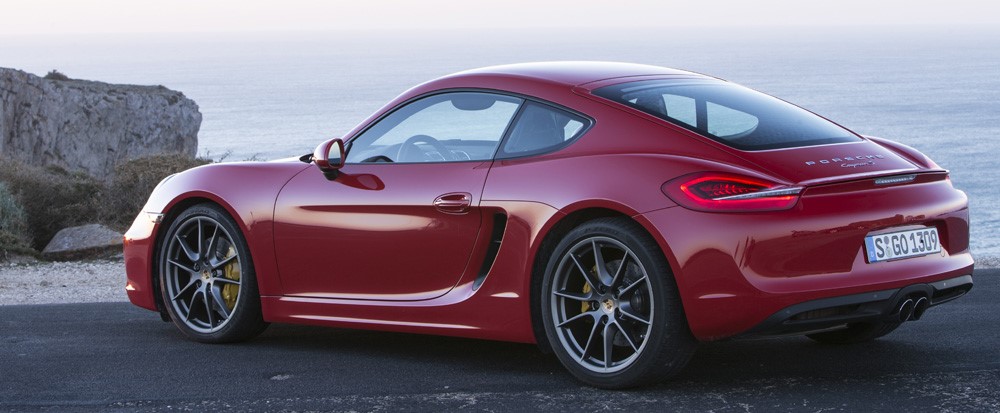
Design
New proportions, prominent lines
A longer wheelbase, shorter overhangs, and larger wheels with a larger overall tire diameter visually reflect the enhanced performance of the new Cayman. Styling cues have been sharpened and are marked by precise lines and sculpted edges that complement the lowered, lengthened profile. The base of the windshield has been pulled forward while the roofline now extends further rearward. The new beltline, rising sharply from the headlamps and continuing through the rear fenders, incorporates the side-view mirrors and epitomizes the more aggressive demeanor of the Cayman. Tapered recesses in both doors channel air into the intakes, a visual indication of the car’s mid-engine orientation and a functional necessity for maximum engine breathing.
The new Cayman enjoys greater visual differentiation from the Boxster as well as its predecessor. The front of the new Cayman includes prominent air intakes right and left and a round cluster of daytime running lights integrated in the trailing upper edge of each intake.
Another distinctive styling element is the large aluminum hatch that extends nearly to the bumper; it meets with a prominent ridge that wraps horizontally into each taillight and integrates a center-mounted LED brake light which spans the entire width of the rear window. Mounted directly to the rear lid is the rear spoiler, a thin blade that is both higher and deploys at a steeper angle than in the Boxster.
Improved engines
The new Cayman is powered by two engines which combine ample torque throughout the operating range with high-rpm power. While base engine displacement has been reduced by 0.2 liter compared with the previous model, power has been increased. With a specific output of 101.6 hp/liter, the base 2.7-liter flat-six pushes the Cayman beyond 100 hp per liter. Both engines now produce maximum horsepower at 7,400 rpm, 200 rpm higher than in the previous generation; both also produce more power at identical engine speeds than their predecessors. The Cayman gains 10 hp and the Cayman S gains five hp over respective last-generation models.
As mentioned, both engines breathe through air intakes on the left and right sides of the car. The 3.4-liter engine in the Cayman S uses an airflow management system that boosts torque at low rpm while increasing top end power and providing a uniform torque curve. Both engines feature variable valve timing and lift (VarioCam Plus) on the intake camshaft for optimal performance throughout the operating range.
Intelligent efficiency
The flat-six cylinder engines in the Cayman use gasoline direct injection, thermal management, electrical system recuperation and auto start/stop to contribute to efficiency gains. Electrical system recuperation is provided by intelligent use of the alternator; the battery receives greater charge from the alternator during braking and coasting. When the battery is fully charged, the generator draws less mechanical energy from the drive belt, which in turn yields more power to the drivetrain for acceleration. Likewise, intelligent control of the combined engine and transmission cooling systems ensures that both reach their operating temperatures sooner. This reduces friction and improves combustion efficiency.
When equipped with the PDK transmission, the new Cayman shares the coasting feature with the Boxster and the 911 Carrera. In this context, coasting refers to vehicle movement absent input from the engine. While coasting, the engine consumes only enough fuel to remain at idle, allowing the vehicle to use kinetic energy during certain portions of a drive. In practical terms, this can result in fuel savings of nearly one half mile per gallon when the vehicle is driven conservatively.
Transmissions
The new Cayman is equipped with a six-speed manual transmission, which features gear ratios carefully matched to power and torque curves for each engine. The optional Porsche Doppelkupplungsgetriebe (PDK) uses two automated clutches and seven gears for automatic shifts with no interruption in power, enabling faster acceleration and better fuel economy.
All new Cayman models feature a standard Sport button. When engaged, it results in more immediate, aggressive engine response; with the PDK transmission gearchanges are executed more rapidly, upshifts are delayed and downshifts occur sooner. Engaging the Sport button in PDK-equipped vehicles also disables engine start/stop and coasting functions. The PDK is specifically tuned to complement the handling capabilities of the new Cayman. In manual mode and with Porsche Stability Management (PSM) deactivated, controlled four-wheel drifts are possible on a closed course at the hands of a skilled driver; by reading yaw angle and steering input angle data in this scenario, the PDK will not upshift, promoting smooth and controllable drifting.
Sport Chrono includes Sport Plus mode and dynamic transmission mounts
The optional Sport Chrono package features PDK transmission settings ranging from aggressive – e.g. for the track – to relaxed, for everyday use. The package also features a Sport Plus button and dynamic transmission mounts. These three systems work in concert to deliver the most rapid launches from rest; a new PDK-equipped Cayman with the Sport Plus button and Launch Control engaged shortens 0-60 mph sprints by 0.2 seconds compared to normal mode. The Sport Plus button also activates the PDK “race course” shifting strategy, which provides quicker and later upshifts for maximum acceleration and performance.
Dynamic transmission mounts alter their stiffness and damping depending upon road conditions and driver input. With the mounts at their stiffest, drivetrain movement within the body is minimized, improving vehicle response especially through corners and quick transitions. The concept is similar to a motorsports vehicle, where the engine is rigidly mounted to the body to eliminate engine movement that can negatively affect handling.
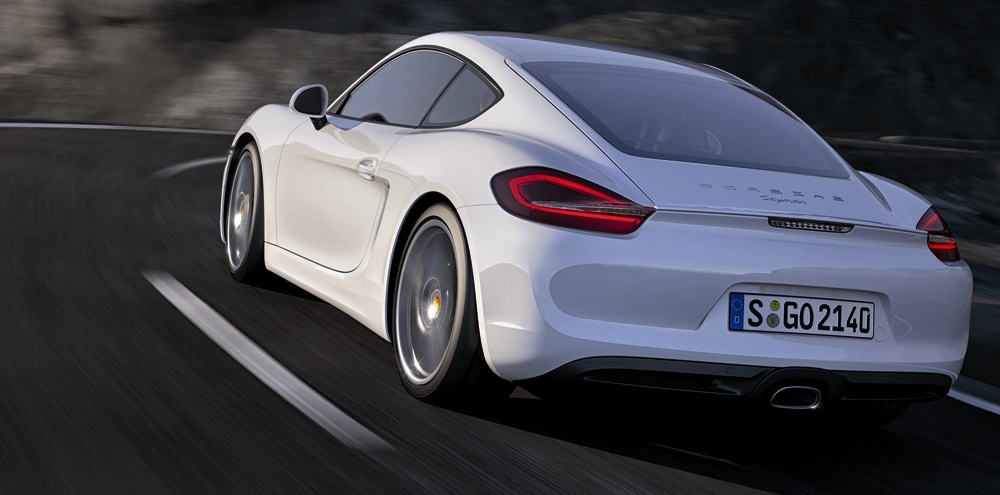

Driving dynamics and agility
New chassis delivers sharpened handling
Chassis changes to the Cayman include a 2.4-inch longer wheelbase for greater stability at speed, a wider track at both axles for stability and cornering agility, and larger diameter wheels and tires for improved grip up to the limits of adhesion. In keeping with the typical Porsche approach, engineers placed a high priority on tuning the chassis for improved performance and agility while improving everyday comfort, efficiency and daily livability.
Revised PASM with additional sensors
The new generation of the optional Porsche Active Suspension Management (PASM) active damping system significantly improves the driving abilities of the Cayman. Four additional vertical sensors at the front and rear wheels enable more finely tuned control of the system. Optimal damping control improves grip, offering greater driving stability, more comfort, enhanced performance and shorter braking distances. The driver can choose between “Normal” and “Sport” modes via the PASM chassis control button located on the center console. The system reacts to driving style and situation; sedate highway driving yields moderate damping for comfort, while aggressive driving results in high damping rates for ultimate grip and chassis control.
Electromechanical steering
Electromechanical power steering replaces the previous hydraulic system in the Cayman. This system provides direct feedback to the driver via the steering wheel while filtering out unpleasant or unnecessary surface irregularities. The system also provides an improvement in fuel efficiency. The optional power steering “Plus” provides extra assist up to 31 mph, greatly easing parking and other low-speed maneuvers. This system also improves steering wheel selfcentering at lower vehicle speeds.
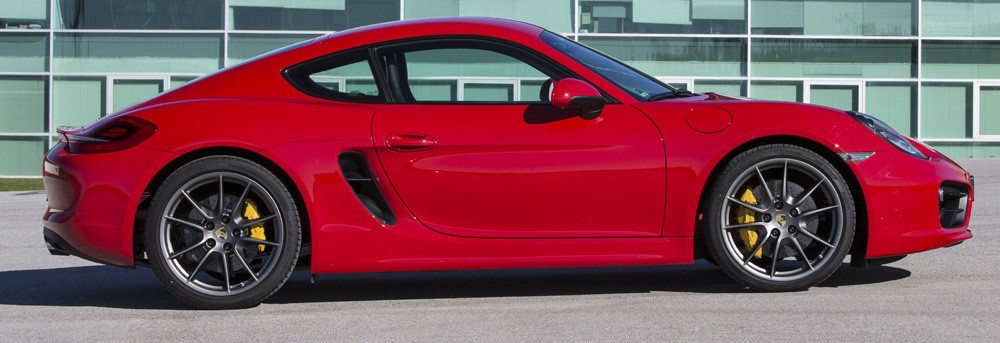
Porsche Torque Vectoring
Building upon the capabilities of the PASM system, the optional Porsche Torque Vectoring (PTV) system is able to increase the performance potential of the Cayman even further. This optional system for increasing dynamic performance and stability varies the distribution of torque to the rear wheels and includes a mechanically locking rear differential. When the car is driven assertively into a corner, moderate brake pressure is applied to the inside rear wheel. Consequently, a greater amount of drive force is distributed to the outside rear wheel, inducing an additional rotational pulse (yaw movement) around the vehicle’s vertical axis. This results in a direct and sporty steering action as the car enters the corner. At low and medium vehicle speeds, PTV significantly increases agility and steering precision. At high speeds and when accelerating out of corners, the rear differential lock ensures greater driving stability on a range of surface conditions, including the wet and snow.
Brakes with extra power
To match the higher performance limits of the new Cayman, the braking system has been enhanced with stiffer front calipers, an optimized brake pad design, larger swept area, and improved cooling of the brake discs. The new Cayman S has larger front brake discs from the 911 Carrera. The high-performance Porsche Ceramic Composite Brake (PCCB) system remains available as an option. This system features 350 mm diameter brake discs at both the front and rear wheels. PCCB brake calipers are painted yellow, and the front brakes feature new six-piston calipers from the 911 Carrera.
Larger wheels, more efficient tires
The new Cayman models ride on wheels and tires one inch larger in diameter than previous models. Unique 18- and 19-inch wheels give the Cayman better lateral stability and handling. Optional for the new Cayman and Cayman S are the 20-inch Carrera S wheels, 20-inch two-color Carrera Classic wheels and new 20-inch Sport Techno wheels. The standard tires feature low rolling resistance (improved by seven percent compared to the previous tires) and low weight but still meet exacting Porsche standards for handling and braking distance.
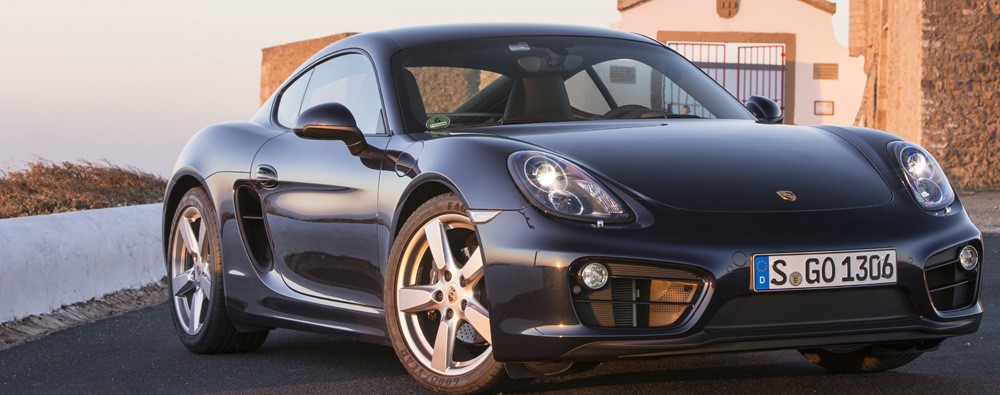
Innovative lightweight body design.
Lighter, stiffer, sportier
The body of the new Cayman is entirely new and is based on the body-in-white design of the Boxster. Innovative lightweight body design with mixed aluminium-steel construction has reduced body-in-white weight by approximately 100 pounds. At the same time, static torsional rigidity is increased by 40 percent. This lighter weight and reduced chassis flex are the foundation for the improvements in the dynamic performance of the Cayman.
Though the extra features, larger glass surfaces and larger wheels of the new Cayman offset some of the weight savings of the body-in-white, weights are nonetheless down across the board compared with previous models. A standard Cayman S weighs 66 pounds less than its predecessor.
In its new lightweight body design strategy, Porsche employs steel only where it is deemed essential; lightweight metals are the preferred choice wherever they can be used. Die-cast aluminum, sheet aluminum, magnesium and high-strength steels are used extensively; fabrication is tailored for specific purposes ensuring very high rigidity values while minimizing material usage. Approximately 44 per cent of the new Cayman body-in-white consists of aluminum; this includes the front body, floor and rear body, the doors and the front and rear trunk lids.
Compared to the previous model, aerodynamic lift is reduced at both axles for greater highspeed stability. Reducing lift at the front axle is a new front spoiler lip; at the rear axle, a new rear wing combined with a spoiler lip running across the entire vehicle work in tandem to reduce lift. A curved rear wing is integrated seamlessly into the body and can be deployed either automatically or manually. With a 40-percent greater air contact area, it generates more downforce than the previous model yet offers less aerodynamic resistance.
New optional features
Elegant ambience, luxurious options
The interior of the new Cayman follows the new Porsche sports car interior design ethos, adding substance and value. New optional features help move the Cayman upmarket and include a high-end Burmester® sound system tailored specifically for the interior of the Cayman, Adaptive Cruise Control (ACC) and the keyless Entry & Drive system. Optional bi-color leather packages lend an exclusive, upscale ambiance to the Cayman’s interior. Lime gold, pebble gray, or amber leather may be combined with the agate gray leather to striking effect.
The center console rises to meet the dash and incorporates a high-set gearshift lever in the motorsports tradition, contributing to an involving, cockpit-like interior. Controls are arranged in logical groups on the center console for quick and intuitive command of individual functions and settings.

New ergonomics promote driver involvement
Improved ergonomics in the Cayman are afforded by the ascending center console and the driver’s seat position, which ensures a short distance between the steering wheel and the gearshift lever. A new gear indicator resides in the tachometer and an upshift recommendation indicator helps the driver maximize fuel efficiency.
A new high-resolution 4.6-inch VGA multifunction screen is located in the rightmost instrument bezel. Along with the most important trip computer functions, it includes a map display for the optional PCM with navigation module. The standard CDR audio system features a seven-inch touchscreen that is centrally located higher on the dash and offers clear and convenient access to multiple functions. The instrument panel features three round instruments as in previous generations, retaining a familiar cockpit feel. It includes a centrallypositioned tachometer and an ignition switch to the left of the steering wheel.
The driver and passenger receive new sport seats that balance long-distance comfort with substantial lateral support for aggressive driving. The standard sport seats have mechanical fore-aft and height adjustments with electric backrest adjustment. The optional sport seat plus offer even greater lateral support by way of larger side bolsters on the seat cushions and backrests and more pronounced sculpting in the shoulder area. Electric sport seats and adaptive sport seats plus, both with memory function, remain optional.
The Cayman’s newly lengthened profile also increases its practicality. A larger hatch offers better access to the rear trunk, and cargo capacity has been increased by 0.5 cubic feet for a total of 15 cubic feet when loaded to the roof. Opening the hatch reveals a new brushed aluminum panel spanning the engine compartment cover between the two filler caps for coolant and engine oil. A luggage partition bar of the same material laterally spans the space behind the head restraints.
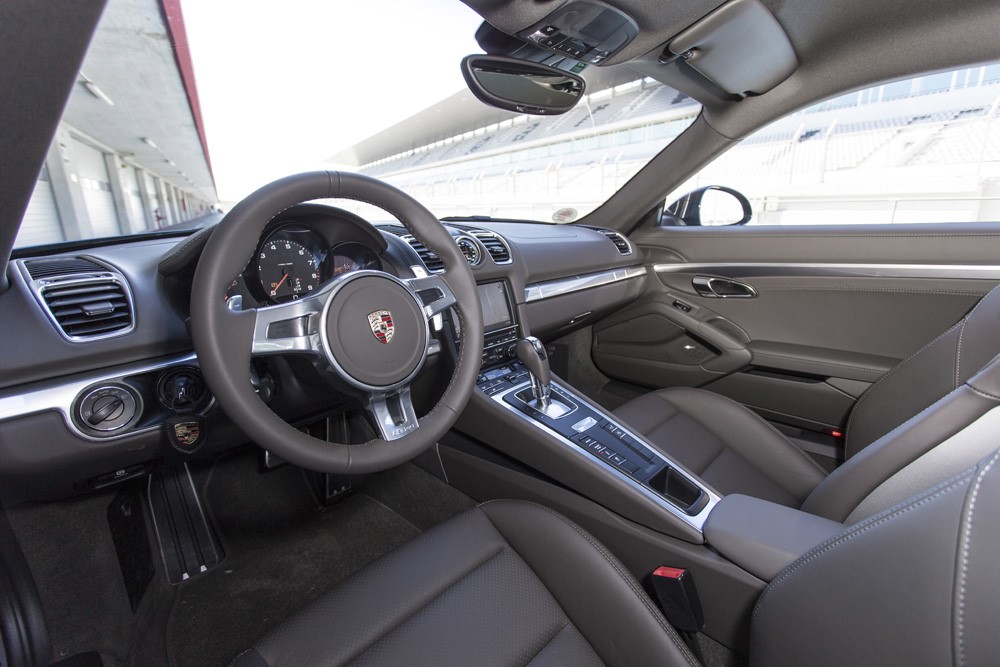
Cayman introduces Burmester® sound system
Working with Burmester®, Porsche developed an optional premium audio system for the Cayman. Based on experience acquired while developing systems for the Panamera, Cayenne and 911 Carrera, the Cayman’s new system delivers impressive power and sound quality. The system features twelve individually-controlled speakers, including an active “body-inwhite” 5.5-inch subwoofer with an integrated 300 Watt Class-D amplifier, and twelve amplifier channels with a total output power of over 800 watts.
Adaptive Cruise Control with Porsche Active Safe
Adaptive Cruise Control (ACC) is now available on Cayman models equipped with the PDK transmission. This system controls vehicle distance and speed in traffic, and is enhanced with the addition of Porsche Active Safe (PAS). ACC’s front-mounted radar scans up to 650 feet in front of the vehicle. Using data from its scan of the lane ahead, ACC maintains one of four driver-selected distances to the vehicle ahead, automatically adjusting vehicle speed as necessary up to a full stop. This feature helps reduce driver fatigue during long commutes and in stop-and-go traffic.
Even with ACC turned off, PAS uses the ACC’s front radar to avoid front-end collisions. It does so by using the front radar to continually monitor traffic for significantly slower vehicles ahead. If the system detects the risk of a front-end collision, it will first prime the brake system and increase brake assist levels. If a collision appears imminent, PAS alerts the driver with an audible alert, a visual indicator, and a brake pedal jolt. If the driver still does not apply the brakes, PAS can apply the brakes with up to maximum force to avoid collision. The driver may choose to deactivate PAS.
Porsche Entry & Drive
Porsche Entry & Drive, which enables keyless unlocking and locking of the doors and both trunks as well as engine starting, is offered for the first time in the Cayman. When the driver touches the door handle, Porsche Entry & Drive queries an access code saved in the key; if the code is a match, the door is unlocked. Similarly, when the driver approaches the sensor zones at the front or rear of the car, the respective trunk unlocks and can be opened.



